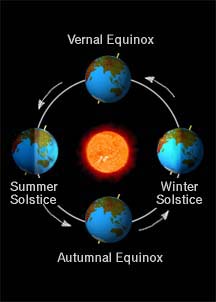The tilt of Earth's rotational axis and the Earth's orbit work together to create the seasons. As the Earth travels around the Sun, it remains tipped in the same direction, towards the star Polaris. This means that sometimes the northern half of the Earth is pointing towards the Sun (summer), and sometimes it is pointing away (winter). These points in the Earth's orbit are called solstices.
Notice that when the northern hemisphere is tilted towards the Sun, the southern hemisphere is tilted away. This explains why the hemispheres have opposite seasons.
Halfway in between the solstices, the Earth is neither tilted directly towards nor directly away from the Sun. At these times, called the equinoxes, both hemispheres receive roughly equal amounts of sunlight. Equinoxes mark the seasons of autumn and spring and are a transition between the two more extreme seasons, summer and winter.


No comments:
Post a Comment